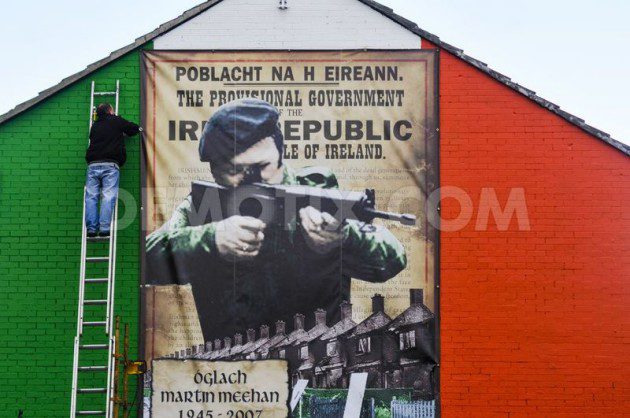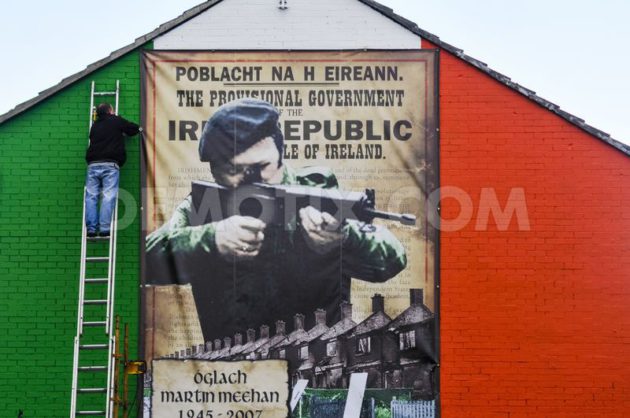I politici unionisti hanno criticato la comparsa di un nuovo murales dedicato all’ex leader IRA di North Belfast Martin Meehan
Meehan fu il primo repubblicano ad essere condannato per appartenenza ai Provisional IRA, e venne imprigionato per 12 anni con l’accusa di rapimento.
Dopo il suo rilascio dalla prigione, il volontario IRA divenne consigliere per lo Sinn Féin ad Antrim nel 2001.
Nel murales è raffigurato in divisa paramilitare mentre prende la mira con una mitragliatrice.
Il murale è una replica di una nota fotografia di Meehan scattata nei primi anni Settanta.
Rappresentanti unionisti hanno espresso indignazione per l’opera d’arte, presentata domenica dai figli di Meehan – Martin Óg, Kevin e Maria – nel sesto anniversario della sua morte .
Martin Óg Meehan ha detto che il murales mostra l’immagine di suo padre accanto alle case in fiamme di Ardoyne. È stato creato per “onorarlo in qualche modo e per onorare il suo contributo alla difesa di Ardoyne contro i pogrom del 1969 e del 1971, lanciati contro la comunità di Ardoyne”.
Il murales, secondo il repubblicano, contiene immagini di difesa e non di offesa.
Meehan ha detto che la gente di Ardoyne ha pagato per il murales, e che non sarebbe stato rimosso.
Nelson McCausland, parlamentare del DUP, ha descritto la mossa come “ripugnante e regressiva”.
“È un tentativo di intimidire la comunità locale ed è opera di persone che cercano di trascinare la società indietro nel sangue e nella violenza”, ha dichiarato.
“Martin Meehan è ritenuto uno dei membri IRA responsabili della morte di tre giovani soldati scozzesi, attirati verso la morte a Ligoniel nel 1971, oltre ad aver compiuto molti altri atti di terrorismo firmati IRA”.
McCausland ha aggiunto: “L’inaugurazione di questo murales, sulla scia dell’inaugurazione di una targa commemorativa per iThomas Begley – attentatore nella bomba di Shankill, a cui hanno partecipato membri dello Sinn Féin, è la prova della lotta interna di potere nel repubblicanesimo – con entrambe le fazioni pronte a indulgere nella vergognosa glorificazione del terrorismo passato, calpestando tutte le sensibilità delle vittime di quella violenza.
“La stragrande maggioranza della società non vuole partecipare a questa lotta interna, né all’elogio del terrorismo. Le immagini di uomini armati sui muri sono qualcosa che appartengono solo ai libri di storia e non hanno posto nella società moderna”.
Il consigliere di Alliance Party, John Blair, ne ha chiesto la rimozione.
“Questa mossa non è rappresentativa della comunità locale, che non vuole vedere l’immagine di un uomo armato sulla porta di casa”, ha detto.
“È difficile vedere come la rappresentazione di uomini armati possa ispirare le persone a svolgere un ruolo costruttivo nella comunità e rende memoria alle parti più buie del nostro passato, piuttosto cheai cambiamenti fatti dalle persone o agli aspetti più positivi del nostro patrimonio”.
Ci fu molto clamore a settembre, quando un murales della UVF ha sostituito quello di uno dei calciatori idoli cittadini, George Best, a East Belfast.
Tratto da Utv
New Ardoyne IRA mural criticised
Unionist politicians have condemned the appearance of a new republican mural depicting former north Belfast IRA leader Martin Meehan.
Meehan was the first person to be convicted of membership of the Provisional IRA, and was jailed for 12 years on kidnapping charges.
Following his release from prison, the IRA volunteer became a Sinn Féin councillor for Antrim in 2001.
He is depicted in the mural in paramilitary-style uniform aiming a machine gun.
The mural is a replica of a well-known photograph of Meehan taken in the early 1970s.
Unionist representatives have expressed outrage at the artwork, which was unveiled by Meehan’s children Kevin, Mary and Martin Óg on Sunday – the sixth anniversary of his death.
Martin Óg Meehan said the mural showed an image of his father alongside burning houses in Ardoyne, and was created “to honour him in some way and honour his contribution to the defence of Ardoyne against the 1969 and 1971 pogroms that were launched against the Ardyone community.”
He said the mural contain images of defence, not offence.
Mr Meehan said that the people of Ardoyne had paid for the mural, and that it would not be removed.
North Belfast DUP MLA Nelson McCausland described the move as “abhorrent and regressive”.
“It is an attempt to intimidate the local community and is the work of people who would seek to drag society backwards into bloodshed and violence,” he stated.
“Martin Meehan is widely believed to have been one of the IRA gunmen responsible for the callous murder of the three young Scottish soldiers lured to their deaths at Ligoniel in 1971, along with many other acts of IRA terrorism.”
Mr McCausland added: “The unveiling of this mural, following on from the unveiling of a plaque commemorating Shankill bomber Thomas Begley which was attended by Sinn Féin, is evidence of the internal power-struggle within republicanism – with both factions indulging in the shameful glorification of past terrorism while trampling all over the sensitivities of the victims of that violence.
“The vast majority of society wants no part in this internal struggle, nor in the eulogising of terrorism. Images of terrorist gunmen on gable walls is something which belongs only to history books and has no place in modern society.”
Alliance North Belfast councillor John Blair urged those behind the mural to remove it.
“This move is not representative of the local community, which does not want to see the image of a paramilitary gunman displayed on their doorsteps,” he said.
“It is difficult to see how the depiction of gunmen can inspire people to play a constructive role in the community and it memorialises the darkest parts of our past, rather than the changes people have made or the more positive aspects of our heritage.”
There was also huge public outcry in September, when a mural of a UVF gunman replaced one of local football icon George Best in east Belfast.

